|
|
|
Sort Order |
|
|
|
Items / Page
|
|
|
|
|
|
|
| Srl | Item |
| 1 |
ID:
162686
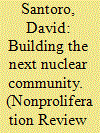

|
|
|
|
|
| Summary/Abstract |
This viewpoint takes stock of the changes in the strategic nuclear landscape in recent decades and reflects on its consequences on the policy community. It finds that the number and scope of issues have expanded considerably; they have manifested themselves in many more regions of the world; and they have become deeply politicized and polarized. The consequences have been twofold: the nuclear policy field has seen the development of an increasingly diverse expert community composed of highly specialized functionalists and regionalists, and it has become ever more divided into two entirely separate ideological camps—one that believes in deterrence, the other in disarmament. The stove-piping of expertise and the widening gap between deterrence and disarmament ideologies are immensely problematic because, in different ways, they stand in the way of the emergence of a better and safer nuclear future. Looking ahead, it is critical to “bust the silos of expertise” and to build bridges between the deterrence and disarmament ideological camps. Only such a community-building effort will help solve today’s and tomorrow’s nuclear challenges.
|
|
|
|
|
|
|
|
|
|
|
|
|
|
|
|
| 2 |
ID:
162679


|
|
|
|
|
| Summary/Abstract |
Recent alleged uses of chemical weapons in Syria and Iraq have led to a renewed interest in the topic. The starting point for modern chemical warfare is World War I, of which much has been written. Interestingly, many of the cases of chemical warfare after that war and prior to World War II are not as fully fleshed out as one might expect, since the most recent case was over seventy-five years ago. This study looks at evidence on cases of chemical warfare from 1919 to 1939 to ask what we know about those cases and what remains to be answered. This period, bookended by the birth of modern chemical warfare and the widely noted pattern of non-use during World War II, was a time of uncertainty about whether and how the production and use of chemical weapons might spread. A number of cases, both those generally accepted and those more contentious, are reviewed, and a few common themes are teased out in the final section of the study. In particular, the norm against chemical weapons during these two decades appeared to be limited to the view that states would generally refrain from being the first to use chemical weapons against European, particularly possessor, states, but in other conflicts the employment of such weapons was at least considered, and occasionally carried out. Many information gaps remain, and it is hoped that the descriptions of the cases will encourage others to carry out further research.
|
|
|
|
|
|
|
|
|
|
|
|
|
|
|
|
| 3 |
ID:
162680
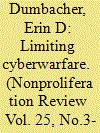

|
|
|
|
|
| Summary/Abstract |
An arms race in cyberspace is underway. US and Western government efforts to control this process have largely been limited to deterrence and norm development. This article examines an alternative policy option: arms control. To gauge whether arms-control models offer useful lessons for addressing cyber capabilities, this article compiles a new dataset of predominantly twentieth-century arms-control agreements. It also evaluates two case studies of negotiated agreements that regulate dual-use technologies, the 1928 Geneva Protocol prohibiting chemical- and biological-weapon use and the 1944 Chicago Convention on International Civil Aviation. The analysis underscores the limits of norm development for emerging technologies with both civilian and military applications. It finds lessons for developing verifiable, international cooperation mechanisms for cyberwarfare in the regulatory model of international aviation. Conventionally, arms-control agreements take advantage of transparent tests or estimates of arms. To restrict cyberwarfare activities, experts and policy makers must adapt arms-control models to a difficult-to-measure technology at an advanced stage of development and use. Further investigation of international regulatory schemes for dual-use technology of similar diffusion and development to the internet, such as international civil aviation, is needed.
|
|
|
|
|
|
|
|
|
|
|
|
|
|
|
|
| 4 |
ID:
162681


|
|
|
|
|
| Summary/Abstract |
Recent scholarship has largely ignored systematic differences in the existential threats that nuclear-weapon possessors pose to other states. This study theorizes that the capacity to pose existential threats shapes nuclear-armed states’ willingness to use military force against one another. We explore three hypotheses regarding how nuclear-based existential threats can deter conflict or encourage it, including under the conditions proposed by the stability–instability paradox. We rely on a statistical analysis of nuclear-armed dyads from 1950 to 2001 and employ the Nuclear Annihilation Threat (NAT) Index to capture variation in the existential threats nuclear-armed states pose to one another. We find that being able to pose an existential threat to another state emboldens potential initiators to use military force but does not deter attacks. The emboldening effects are particularly strong under the hypothesized conditions of the stability–instability paradox. Our study provides unique contributions to ongoing debates over the political effects of nuclear weapons.
|
|
|
|
|
|
|
|
|
|
|
|
|
|
|
|
| 5 |
ID:
162683
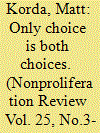

|
|
|
|
|
| Summary/Abstract |
Conventional theories of alliance management often overemphasize the utility of either assurance or coercion in preventing allied nuclear proliferation. Historical analysis reveals that prioritizing either of these two tactics to the exclusion of the other is inadvisable. A strategy that focuses solely on security guarantees or coercive threats is likely to encourage an allied state to pursue a hedging strategy, in which the client state continues to clandestinely develop its own nuclear capabilities while remaining underneath its patron’s defensive “umbrella.” This article introduces a new framework for understanding the effectiveness of nonproliferation-focused alliance-management strategies. By exploring the cases of West Germany and South Korea, the article concludes that the best way to prevent allies from pursuing nuclear weapons is to combine assurance with coercion. This establishes an incentive–punishment relationship that limits an ally’s motivation to develop nuclear weapons. These conclusions have particular salience today, as conversations over nuclear-weapons development have become increasingly normalized in Germany and particularly in South Korea. The United States’s capacity to influence its allies’ nuclear behavior is currently being eroded through the degradation of both patron credibility and client dependence, weakening the long-term viability of the global nonproliferation regime.
|
|
|
|
|
|
|
|
|
|
|
|
|
|
|
|
| 6 |
ID:
162684
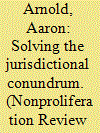

|
|
|
|
|
| Summary/Abstract |
Over the past two decades, the United States has increasingly turned to targeted sanctions and export restrictions, such as those imposed against Iran and North Korea, in order to curb the spread of weapons of mass destruction. One vexing problem, however, is how to contend with jurisdictional hurdles when the violations occur overseas, in countries that are unable or unwilling to assist US enforcement efforts. To solve this problem, US prosecutors are turning to strategies with significant extraterritorial implications— that is, exercising legal authority beyond national borders. One such tool is to use civil legal procedures to seize assets linked to sanctions or export-control violations in jurisdictions that lack cooperative arrangements with US enforcement agencies. While this may be an attractive strategy to bolster enforcement efforts against overseas illicit procurement, using such tools is not without consequence. This article explores the political, legal, and technical implications of enforcing extraterritorial controls against overseas non-state actors by exploring the recent uses of civil-asset forfeiture against Iranian and North Korean procurement networks.
|
|
|
|
|
|
|
|
|
|
|
|
|
|
|
|
| 7 |
ID:
162682
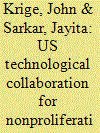

|
|
|
|
|
| Summary/Abstract |
Although the existing international-relations scholarship argues that technological assistance in the nuclear domain increases the probability of nuclear proliferation, the historical account indicates otherwise. Congressional legislation for nonproliferation, economic sanctions, and poor state capacity—specifically, inept managerial capabilities of the recipient state—explain merely part of the puzzle, but overlook the role of positive inducements offered to impede nuclear proliferation. Historical evidence shows that the United States often provided technological assistance with the deliberate intent to inhibit proliferation. In other words, Washington employed its technological leverage to attain nonproliferation goals. American technological preponderance since the end of World War II made such an approach feasible. This study examines key Cold War cases—Israel/Egypt, India, and West Germany—where the United States offered technological assistance with the deliberate intent to stall nuclear proliferation, thereby underscoring the role of assistance for inhibitive ends.
|
|
|
|
|
|
|
|
|
|
|
|
|
|
|
|
| 8 |
ID:
162685


|
|
|
|
|
| Summary/Abstract |
Relations between the United States and Russia are in a prolonged downward spiral. Under these circumstances, cooperation on nuclear issues—once a reliable area of engagement even in difficult political environments—has all but completely halted. There are urgent reasons to find a way out of this situation, particularly the expiration of the New Strategic Arms Reduction Treaty in 2021. However, seemingly intractable disagreements about noncompliance with the Intermediate-range Nuclear Forces Treaty and US ballistic-missile defense, compounded by the Ukraine crisis, the conflict in Syria, and the accusations of Russian interference in the US election of 2016, threaten the future of arms control. Against this backdrop, policy makers and practitioners should identify ways to re-engage on nuclear issues now so they can be ready to implement them as soon as feasible. This article considers how the Comprehensive Nuclear-Test-Ban Treaty (CTBT) could serve as a platform for US–Russia cooperation on nuclear issues when circumstances permit. Taking into account the challenges posed by ongoing US non-ratification, it identifies a menu of CTBT-related activities short of ratification that the two countries could undertake together. It explores how joint work on this issue would advance shared US and Russian interests while helping to create the circumstances necessary for further arms-control work.
|
|
|
|
|
|
|
|
|
|
|
|
|
|
|
|
|
|
|
|
|